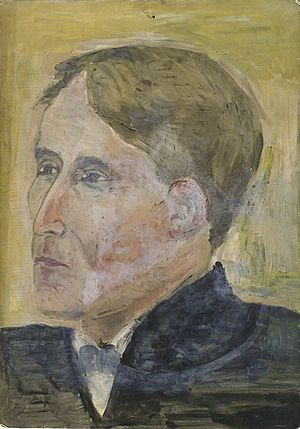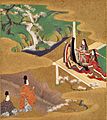Arthur Waley facts for kids
Quick facts for kids
Arthur Waley
|
|||||||||
|---|---|---|---|---|---|---|---|---|---|

A portrait of Waley by Ray Strachey
|
|||||||||
| Born | 19 August 1889 |
||||||||
| Died | 27 June 1966 (aged 76) London, England
|
||||||||
| Resting place | Highgate Cemetery | ||||||||
| Alma mater | Cambridge University (did not graduate) | ||||||||
| Known for | Chinese/Japanese translations | ||||||||
| Chinese name | |||||||||
| Traditional Chinese | 亞瑟・偉利 | ||||||||
| Simplified Chinese | 亚瑟・伟利 | ||||||||
|
|||||||||
| Japanese name | |||||||||
| Kana | アーサー・ウェイリー | ||||||||
|
|||||||||
Arthur David Waley (born Arthur David Schloss, 19 August 1889 – 27 June 1966) was an English expert in Asian cultures. He was especially known for his amazing translations of Chinese and Japanese poetry. He was very popular and respected by scholars for his work.
Waley received many important awards. These included the CBE in 1952, the Queen's Gold Medal for Poetry in 1953, and he became a Companion of Honour in 1956.
Even though he was very smart and learned, Waley chose not to work in universities. He preferred to write for everyone, not just other experts. He translated many different kinds of classic literature from China and Japan.
He started translating in the 1910s and continued almost until he passed away in 1966. His first translations were poems, like A Hundred and Seventy Chinese Poems (1918) and Japanese Poetry: The Uta (1919). Then he translated famous novels, such as The Tale of Genji (1925–26) from 11th-century Japan, and Monkey from 16th-century China.
Waley also wrote about Chinese philosophy and created biographies of important writers. He was always interested in both Asian and Western art. People today remember Waley as the person who helped English readers learn about the rich cultures of China and Japan. He was like an "ambassador" between East and West in the early 1900s.
He taught himself Chinese and Japanese and became very good at both languages. This was a special achievement that was unique for his time.
Contents
Arthur Waley's Early Life and Education
Arthur Waley was born Arthur David Schloss on August 19, 1889. His birthplace was Tunbridge Wells, Kent, England. His father, David Frederick Schloss, was an economist.
Arthur went to Rugby School and then to King's College, Cambridge in 1907. He received a scholarship to study Classics, which includes ancient Greek and Roman languages and cultures. However, he left Cambridge in 1910 because he had eye problems that made it hard for him to study.
Working at the British Museum
After leaving university, Waley briefly worked for an export company. This was to try and please his parents. But in 1913, he got a job at the British Museum. He became an Assistant Keeper of Oriental Prints and Manuscripts.
His boss at the Museum was a poet and scholar named Laurence Binyon. Waley taught himself to read Classical Chinese and Classical Japanese. He did this partly to help organize the paintings in the Museum's collection.
It's interesting that even though he translated so much, he never learned to speak modern Chinese or Japanese. He also never visited China or Japan.
Changing His Name
Waley came from a Jewish family. In 1914, he changed his last name from Schloss. Many people in England with German last names did this during World War I. They wanted to avoid unfair treatment because of anti-German feelings in Britain.
Life as a Translator
Arthur Waley had a close companion named Beryl de Zoete. She was an English ballet dancer and expert in Asian culture. They met in 1918 and stayed together throughout his life.
In 1929, Waley left the British Museum. He wanted to spend all his time writing and translating. He never had another full-time job after that. However, he did work for four years in the Ministry of Information during World War II.
In September 1939, he was asked to lead the Japanese Censorship Section. His job was to check messages from Japanese journalists in London. He also checked private mail in Japanese and secret diplomatic messages.
Waley lived in an area of London called Bloomsbury. He had many friends who were part of the Bloomsbury Group, a famous group of writers and thinkers. He met many of them when he was at university.
The poet Ezra Pound helped Waley get his first translations published. Waley was very careful to make sure his translations kept the original meaning. He believed meaning was more important than just making the English sound pretty.
Arthur Waley married Alison Grant Robinson in May 1966. This was just one month before he passed away on June 27, 1966. He is buried in Highgate Cemetery in London.
The writer Sacheverell Sitwell said that Waley was "the greatest scholar and the person with most understanding of all human arts" he had ever known.
Awards and Recognition
Arthur Waley received several important honors for his work:
- In 1945, he became an honorary fellow of King's College, Cambridge.
- In 1952, he received the Commander of the Order of the British Empire (CBE).
- In 1953, he was awarded the Queen's Gold Medal for Poetry.
- In 1956, he became a Order of the Companions of Honour (CH).
Key Works and Translations
Waley translated many important books and poems. His translations are still widely read today.
Some of his most famous translations include:
- A Hundred and Seventy Chinese Poems (1918)
- Japanese Poetry: The Uta (1919)
- The No Plays of Japan (1921)
- The Tale of Genji (published in 6 parts from 1921 to 1933)
- The Pillow Book of Sei Shōnagon (1928)
- Monkey (1942), which is a shorter version of the Chinese novel Journey to the West
- The Poetry and Career of Li Po (1959)
- The Secret History of the Mongols and Other Pieces (1964)
Waley won the James Tait Black Memorial Prize for his translation of Monkey. His translations of classic Chinese philosophy, like the Analects of Confucius and The Way and Its Power (Tao Te Ching), are still available today. His book Three Ways of Thought in Ancient China (1939) also explains classical Chinese philosophy.
Many people consider Waley's translations of poetry to be like poems themselves. They have been included in many famous poetry collections. His works are often republished as Penguin Classics and Wordsworth Classics, reaching many readers.
Even though he translated so much from Chinese and Japanese, Waley never traveled to either country. He also never went anywhere else in East Asia. He once wrote that he wasn't a master of many languages. But he said he knew Chinese and Japanese quite well. He also knew a good amount of Ainu and Mongolian, and some Hebrew and Syriac.
The famous composer Benjamin Britten used six of Waley's translations from Chinese Poems (1946) for his song collection Songs from the Chinese (1957).
Selected Works by Arthur Waley
Translations of Asian Classics
- A Hundred and Seventy Chinese Poems, 1918
- More Translations from the Chinese (Alfred A. Knopf, New York, 1919).
- The Story of Ts'ui Ying-ying (Yingying zhuan) – pp. 101–113
- The Story of Miss Li (The Tale of Li Wa) – pp. 113–136
- Japanese Poetry: The Uta, 1919. This book mostly included poems from the Man'yōshū and the Kokinshū.
- The Nō Plays of Japan, 1921
- The Temple and Other Poems, 1923
- The Tale of Genji, by Lady Murasaki, 1925–1933
- The Pillow Book of Sei Shōnagon, 1928
- The Way and Its Power: A Study of the Tao Te Ching and its Place in Chinese Thought, 1934. This book included a detailed explanation of Tao Te ching and a full translation.
- The Book of Songs (Shih Ching), 1937
- The Analects of Confucius, 1938
- Three Ways of Thought in Ancient China, 1939
- Translations from the Chinese, a collection of his works, 1941
- Monkey, 1942, a translation of 30 chapters from Wu Cheng'en's Journey to the West
- Chinese Poems, 1946
- 77 Poems, Alberto de Lacerda, 1955
- The Nine Songs: A Study of Shamanism in Ancient China, Qu Yuan, 1955
- Yuan Mei: Eighteenth-Century Chinese Poet, 1956
- Ballads and Stories from Tun-Huang, 1960
Original Works by Arthur Waley
- Introduction to the Study of Chinese Painting, 1923
- The Life and Times of Po Chü-I, 1949
- The Poetry and Career of Li Po, 1950 (this book also included some of his original translations)
- The Real Tripitaka and Other Pieces, 1952 (with some new and old translations)
- The Opium War through Chinese Eyes, 1958
- The Secret History of the Mongols, 1963 (with original translations)
Images for kids
-
An E-maki scroll painting from The Tale of Genji (chapter 5 – "Young Murasaki") by Tosa Mitsuoki.
See also
 In Spanish: Arthur Waley para niños
In Spanish: Arthur Waley para niños
- List of Bloomsbury Group people



